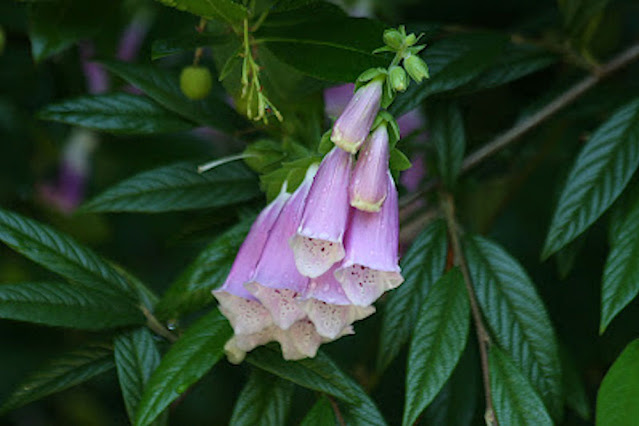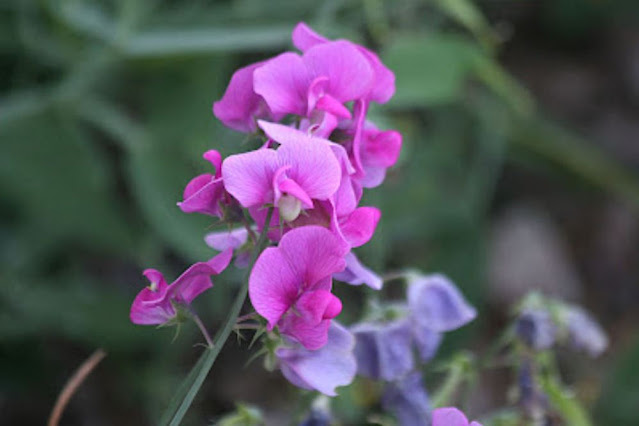I haven't shared any flowers for a while, so I went back into my archives. These are The Tom Kubota Stroll Garden in Seattle, during the summer of 2010.
Heavenly Bamboo or Nandina domestica
This plant really doesn’t look much like real bamboo, maybe the leaves come close to the bamboo leaves. It is, in fact, a shrub that grows bright red berries after flowering white in spring.It comes from Eastern Asia and is now considered an invasive species in Southern states because it is very drought tolerant and tough.
Panicle Hydrangea or Hydrangea macrophylla.
While other big-leaved hydrangeas frequently fail to bloom, these never disappoint, so I read. It is native to Japan and grows 3 to 16 feet.
Mountain Hydrangea or Hydrangea serrata.
It is native to Japan and Korea and is prized for its ornamental beauty and unique flower clusters. Colors range from blue to pinkish red, depending upon soil pH, and features a flattened cluster of flowers. It needs ample sunlight but will benefit from partial afternoon shade.
Common Foxglove or Digitalis purpurea.
It is a biennial or short-lived herbaceous perennial from western Europe. This plant, also sometimes commonly called purple foxglove, fairy gloves, fairy bells, lady’s glove, and many other things.Mountain bluets are similar in appearance to their annual cousins, the cornflower. However, its perennial nature and ease of care have spread across the British Isles, Scandinavia, and North America. In fact, in British Columbia, it has spread so aggressively that it’s now considered an invasive weed.
This is an upright, vase shaped small tree with very pretty white and grey green variegated leaves that light up shady to partially shaded areas in the garden. In spring the leaves are highlighted in pink. In fall the leaves take on a deep scarlet red color. They can reach reach 12 feet tall and 6 to 8 feet wide and maybe 1/2 that size in containers.
The Perennial Pea - Lthyrus latifolius
Also known as Wild Sweet Pea and Everlasting Pea.
The plant is a member of the Fabaceae family and a native of the Mediterranean (northern Africa and southern Europe). The genus name comes from the Greek word for pulse or pea Lathyrus. Its specific species latifolius means “broad-leaved.” Everlasting pea climber has a trailing and climbing habit and grows to a height of 6′ to 9′ feet with a spread of 3′ to 6′ feet. When left to its own devices with nothing to climb, the plant will ramble as far as it can grow as a groundcover approximately 4″ to 8″ inches high. When it has support, it will climb to a height of 6′ to 9′ feet.








Thank you for this beautiful big bunch of flowers. Much appreciated.
ReplyDeleteYou are very welcome Sue, so glad you enjoyed them :)
DeleteReally enjoyed these!
ReplyDeleteThat's great Christine, always happy you enjoy :)
DeleteHow nice to see your lovely photos of flowering plants, Denise. I can attest to Nandina being invasive. As lovely as it is, I have been removing it for years in my garden. A dear gardening neighbor shared it with me years ago and it immediately began running all over the place.
ReplyDeleteThank you Martha Ellen, and how interesting about the Nandina. I learn something new every day :)
DeleteBeautiful!
ReplyDeleteThank you Sandi :)
DeleteThese are pretty.
ReplyDeleteI agree William, flowers always make me feel cheery :)
DeleteOhhhhh, this post and your photos brightened my afternoon!!!
ReplyDeleteCan't tell you how happy that makes me Anni :) Thank you!
DeleteBeautiful flowers and great photography.Hope you are keeping well.
ReplyDeleteThank you Diane, all goes well here. Just been over to see your latest post and I loved it :)
DeleteLooks like a beautiful garden. All those years we lived in the Seattle area and I never heard of this garden. :)
ReplyDeleteThan Ellen, I hope to get back there one day :)
DeleteBeautiful blooms! Stay warm.
ReplyDeleteThanks Linda, you too :)
DeleteThis is the perfect post. This time of year I miss seeing flowers. These are all so pretty.
ReplyDeleteMe too Ann, I am looking forward to growing season again :) Thank you!
DeleteMuito bonitas estas flores silvestres.
ReplyDeleteUm abraço e bom fim-de-semana.
Andarilhar
Dedais de Francisco e Idalisa
O prazer dos livros
Muito obrigado! Um abraço e continuação de boa semana :)
DeleteHello, Denise
ReplyDeleteThe flowers are so pretty, lovely to see. I am looking forward to the spring blooms.
Take care, enjoy your day! Have a happy weekend!
Hello Eileen, thank you and yes, something to look forward too. You take care and enjoy your day also, and a happy rest of the week to you:)
DeleteThese are very welcome during a cold winter!
ReplyDeleteSo happy you enjoyed Jeanie, thank you :)
Deletethey are all spectacular, and the white hydrangea is magnificent!
ReplyDeleteThanks Sandra, they are a delight aren't they? :)
DeleteBeautiful collections of flowers.
ReplyDeleteAmazing looking of Cornflower Perennial Mountain Bluet. Have a great weekend.
Thank you babYpose, happy you enjoyed :)
DeleteVery beautiful flowers. The pea looks like a Vanda Orchid.
ReplyDeleteThanks Gigi, interesting about the sweet pea. These grew on a trellis in my father's garden. I loved them!
DeleteThese are so beautiful, and so fun to see in this cold. I would love to see that maple in spring and fall.
ReplyDeleteI'm glad you enjoyed them Rose, they cheered me up when I came across them :) I love maple trees in both spring and fall. These leaves are so pretty and they can be quite spectacular at those other times.
DeleteHow beautiful these flowers are.
ReplyDeleteAll the best Jan
Thank you Jan and all the best to you too :)
DeleteBeautiful flowers. Some of them look quite unusual.
ReplyDeleteThanks Great-Granny Grandma :) I enjoy going to different areas and some flowers I recognize and others I don't.
Delete